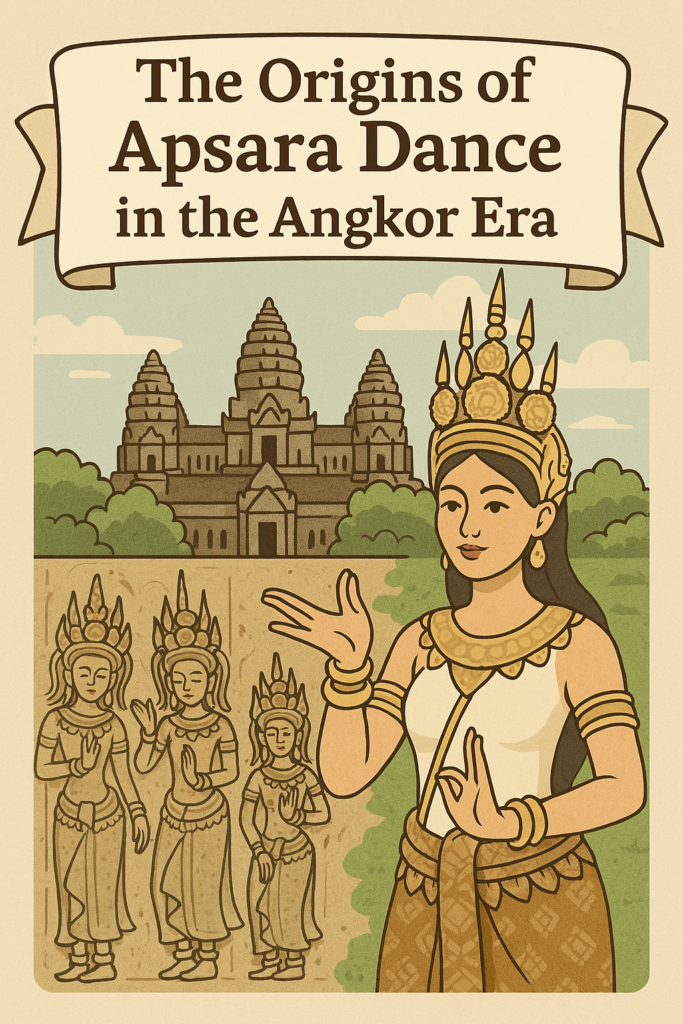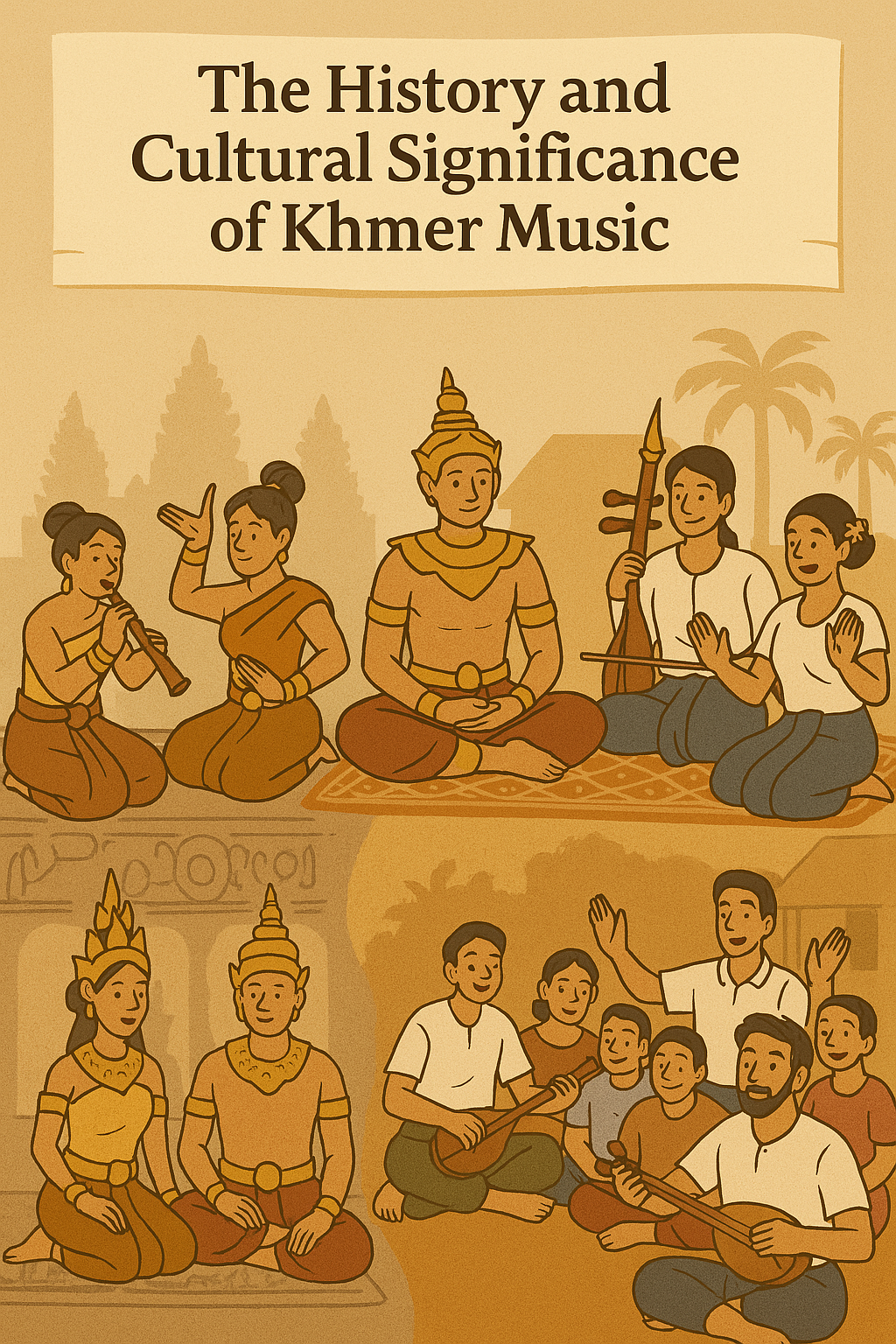Apsara Dance is more than a beautiful art form—it is a living embodiment of Cambodia’s spiritual, historical, and cultural legacy. Rooted in ancient temples and reborn through resilience, this sacred classical dance continues to mesmerize audiences worldwide. Let’s explore the origins, meanings, and modern-day significance of this enchanting tradition.

1. The Origins of Apsara Dance in the Angkor Era
The Apsara dance traces its roots to the Angkorian Empire (9th–15th centuries), one of Southeast Asia’s greatest civilizations. The term “Apsara” refers to celestial nymphs or divine female spirits in Hindu and Buddhist mythology, believed to dance in the heavens to entertain gods and kings.
These celestial dancers are immortalized in stone at Angkor Wat, Bayon, and other temples, where over 1,500 Apsara carvings depict their flowing postures and serene expressions. These reliefs are not just decorative—they are a sacred visual language, linking the spiritual world with the earthly realm through dance.
2. The Symbolism Behind Apsara Hand Gestures (Mudras)
Apsara dance is a highly codified art form, where each movement, hand gesture (mudra), and pose carries symbolic meaning. With over 1,500 distinct hand gestures, the Apsara dancer tells mythological stories, expresses emotion, and invokes blessings.
Some common mudras include:
- Flower blooming gesture: Symbolizing purity and beauty.
- Flying bird gesture: Representing freedom and transcendence.
- Offering gesture: Denoting devotion and respect to deities or royalty.
These movements require years of rigorous training, with an emphasis on precision, balance, and grace—mirroring the celestial ideal.
3. The Meaning of Costumes and Accessories in Apsara Dance
Apsara dancers wear elaborate costumes inspired by the temple bas-reliefs:
- Sampot Sarabap: A long, pleated silk skirt often made from traditional Cambodian textiles.
- Golden headdress (Mokot): Adorned with floral motifs and spikes representing the sacred Mount Meru.
- Gold-plated jewelry: Armlets, earrings, and belts symbolize divine splendor.
- Barefoot performance: Signifying connection to the sacred earth and ancient tradition.
Each accessory is meticulously chosen to enhance not just beauty but symbolic spiritual energy.
4. Famous Apsara Dancers and Their Role in Preserving the Tradition
No discussion of Apsara dance is complete without mentioning Princess Norodom Buppha Devi (1943–2019), daughter of King Norodom Sihanouk. Trained in classical dance from a young age, she became a national icon and revived Apsara as a performance art in the 1960s.
Her legacy inspired institutions like the Royal University of Fine Arts and various dance conservatories across Cambodia. Today, contemporary masters like Sophiline Cheam Shapiro continue this legacy by blending tradition with innovation.
5. Apsara Dance Performances in Royal Ceremonies
Historically, Apsara dance was performed only in the royal courts and religious ceremonies. Dancers served not just as entertainers but also as ritual specialists, believed to bring prosperity, divine favor, and cosmic balance.
During royal coronations, blessings, and temple festivals, Apsara dancers would enact scenes from the Reamker (Khmer Ramayana) and ancient myths, reinforcing the divine right of kings and the kingdom’s harmony with the universe.
6. The Revival of Apsara Dance After the Khmer Rouge Era
The Khmer Rouge regime (1975–1979) brought near-total destruction to Cambodia’s artistic heritage. Countless dancers and teachers were killed, and classical dance nearly vanished.
However, the post-war revival of Apsara dance became a symbol of national healing. Survivors trained new generations, reconstructed choreographies from memory, and reignited public interest.
Thanks to UNESCO recognition in 2003 (as a Masterpiece of the Oral and Intangible Heritage of Humanity), Apsara dance now thrives again, not just in Cambodia, but also on global stages.
7. Where to Watch Authentic Apsara Performances in Cambodia
For travelers and enthusiasts, here are some of the best places to witness authentic Apsara dance today:
- Apsara Theatre (Siem Reap) – Traditional performances with classical orchestras.
- National Museum of Cambodia (Phnom Penh) – Cultural evenings featuring Apsara and other dances.
- Royal University of Fine Arts (Phnom Penh) – Student showcases and special events.
- Temple Gala Dinners – Especially in Siem Reap, where Apsara dances accompany Cambodian cuisine.
Watching a performance near the temples of Angkor creates an unforgettable atmospheric link between the past and the present.
8. Differences Between Apsara Dance and Other Southeast Asian Classical Dances
While classical dance exists across Southeast Asia, Apsara dance stands apart through:
- Khmer Mudra System: Unique hand gestures and storytelling technique.
- Temple Origins: Unlike Thai or Balinese court dances, Apsara is rooted in temple cosmology.
- Symbolism of Movement: Each Apsara step embodies spiritual discipline and cosmic meaning.
Comparisons with Thai Lakhon, Balinese Legong, or Javanese Bedhaya reveal shared influences—but Apsara remains distinctly Khmer in spirit, grace, and symbolism.
Conclusion: A Sacred Dance That Moves the Soul
Apsara dance is not merely a cultural artifact—it is a living, breathing connection to Cambodia’s soul, linking history, myth, and modern identity. Its continued survival and elegance speak volumes about the resilience of Cambodian heritage.
Whether viewed as a spiritual practice, an art form, or a national symbol, Apsara dance invites us all to pause, reflect, and marvel at the elegance of Khmer civilization.





